Top
 General plan of the workshop Beola 2
General plan of the workshop Beola 2
 In the picture, from left to right; first row: Bernardo Forni, Lorenzo Crescioli, James Walker; second row: Peter Kuon, Giorgio Buccellati, Mrs. Kuon, Marilyn Kelly-Buccellati, Jonah Lynch, Laerke Recht, Jessica Scaciga, Amer Ahmad, Marco De Pietri, Samer Abdel-Ghafour
In the picture, from left to right; first row: Bernardo Forni, Lorenzo Crescioli, James Walker; second row: Peter Kuon, Giorgio Buccellati, Mrs. Kuon, Marilyn Kelly-Buccellati, Jonah Lynch, Laerke Recht, Jessica Scaciga, Amer Ahmad, Marco De Pietri, Samer Abdel-Ghafour
Back to top: Extended Report
Introduction
 (In the picture, from left to right; back: Marilyn Kelly-Buccellati; left side: Hiba Qassar, Jessica Scaciga, Laerke Recht, Amer Ahmad, Giorgio Buccellati; right side: Samer Abdel-Ghafour, James Walker, Lorenzo Crescioli, Bernardo Forni).
(In the picture, from left to right; back: Marilyn Kelly-Buccellati; left side: Hiba Qassar, Jessica Scaciga, Laerke Recht, Amer Ahmad, Giorgio Buccellati; right side: Samer Abdel-Ghafour, James Walker, Lorenzo Crescioli, Bernardo Forni).
During the period September 5–12, 2022, a second workshop was taken in Beola, gathering many members of the Urkesh/Tell Mozan’s staff, involved in different aspects related to the many projects connected to the ancient site of Tell Mozan and the parallel projects pertaining to the “4Banks” websites.
The following members attended the workshop in person: Prof. Giorgio Buccellati; Prof. Marilyn Kelly-Buccellati; Amer Ahmad; Lorenzo Crescioli; Marco De Pietri; Bernardo Forni; Samer Abdel Ghafour; Jonah Lynch; Hiba Qassar; Laerke Recht; Jessica Scaciga; James Walker.
Attending the seminar from remote was also granted to other members, uncapable to attend the event in person: Prof. Federico Buccellati; Sarah Comelli; Stefania Ermidoro; Arwa Kharobi; Yasmine Mahmoud; Mary Stancavage.
The daily work of the team was divided into a morning session (9 AM to 12 noon) and an afternoon session (2:30 PM to 7 PM).
The sessions were also divided into two distinct categories: specialized sessions (on Monday, September 5 and from Friday, September 9 to Monday, September 12) and general sessions (from Monday, September 5 to Thursday, September 8). General sessions were intended to provide the whole team with a general overview of the many ongoing projects and the main trajectories leading the communal work within the frame of the overall “Cybernetica Mesopotamica Balzan Research Project 2022-2025”; the specialized sessions were instead dedicated to different specific works and the whole team spitted into smaller working groups focused on singular projects which are briefly described in the following paragraphs.
Back to top: Extended Report
Monday, September 5
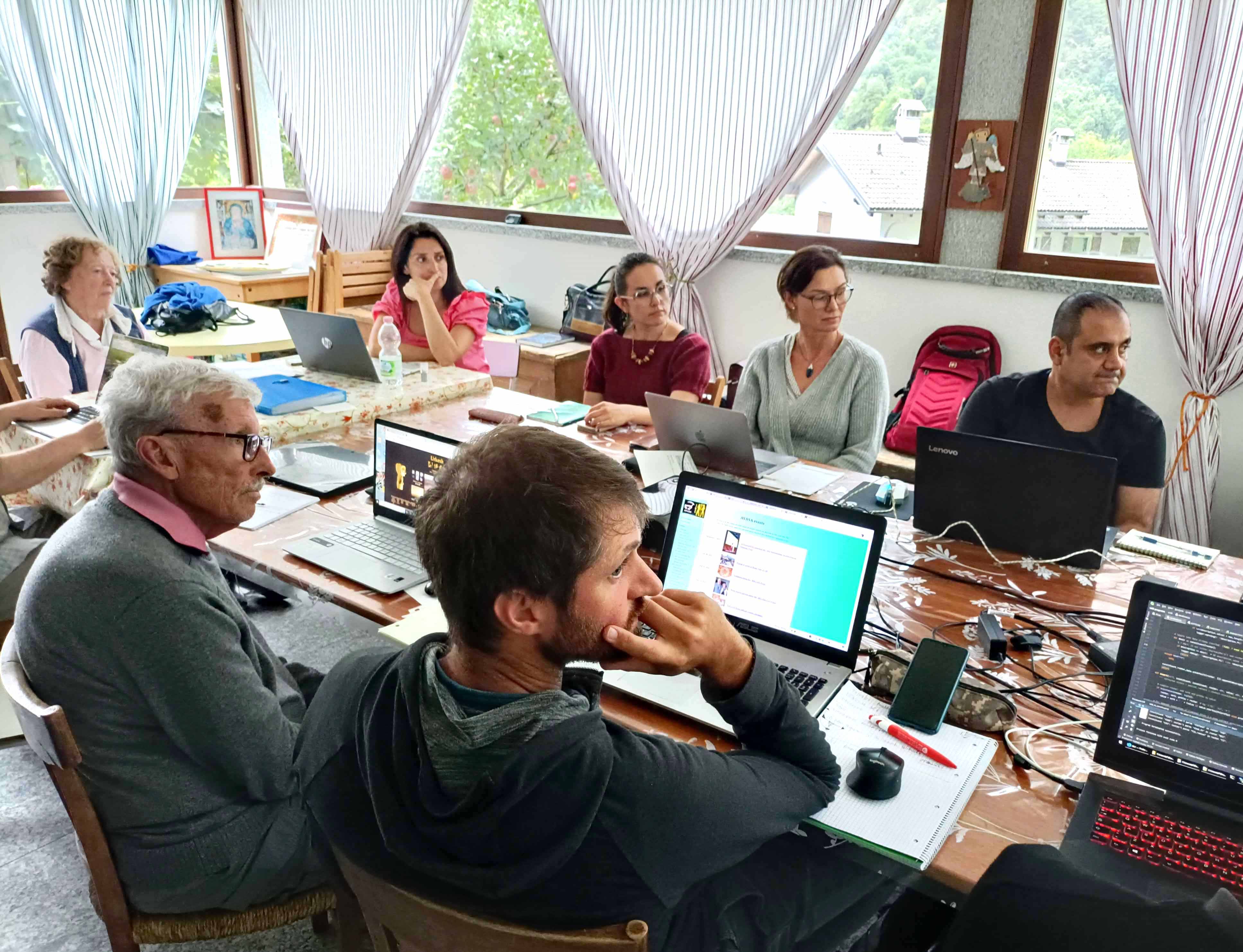 (In the picture, from left to right; first row: James Walker, Lorenzo Crescioli; left side: Marilyn Kelly-Buccellati; right side: Hiba Qassar, Jessica Scaciga, Laerke Recht, Amer Ahmad).
(In the picture, from left to right; first row: James Walker, Lorenzo Crescioli; left side: Marilyn Kelly-Buccellati; right side: Hiba Qassar, Jessica Scaciga, Laerke Recht, Amer Ahmad).
Back to top: Extended Report
Morning Session – technical review of the UGR program
On Monday, September 5, the team dedicated the morning specialized session to the technical review of the new UGR (“Urkesh Global Record”) program. The UGR is the core of the urkesh.org website: its first aim consists in providing a digital publication of the data related to the excavation conducted at Tell Mozan; it is divided into different digital books, which can be divided into two different categories: “unit books”, dedicated to specific units (for instance A12, about the ābi, or A16, on the courtyard of the Tupkish palace) and “topical books”, devoted to an in-depth analysis of specifical themes or topics (such as the “Grammar of the Archaeological Record”, the “Ceramics” and the “Glyptics” of Urkesh). In this morning session, Prof. Giorgio Buccellati presented a discussion about the main features of this section of the website, stressing the importance of the publication of archeological data in a digital format, and focusing on the key principles at the ground of this section of the website, that is the transparency of the given information, and the internal coherence of the entire system which needs to be regarded in the frame of a “digital discourse” (for this concept, see below, Friday, September 9, afternoon session). Regarding the technical issues involving the UGR, the team focused the attention on the structure of the digital books, which are structured according to a fixed and determined format: a “left-hand side”, displaying a synthesis of the main topics regarding a specific unit or topic, a “main frame” (the center of the webpage), where the information is displayed, and a “right-hand side”, which is instead devoted to specific aspects of the unit (items, features, etc.).
Back to top: Extended Report
Afternoon Session – the new UGR program: current status and desiderata
In the afternoon of Monday, September 5, a general session has been dedicated to the current status and future desiderata of the UGR system as a whole. For what concerns technical issues, Bernardo Forni explained how a new program (integrating the current JD and DABI programs) will allow easier input of data and a clearer display of the final information (output). Then, the members of the team in charge of the development of a specific book presented a short report about the previous, current, and future work on their respective digital books.
Back to top: Extended Report
Tuesday, September 6
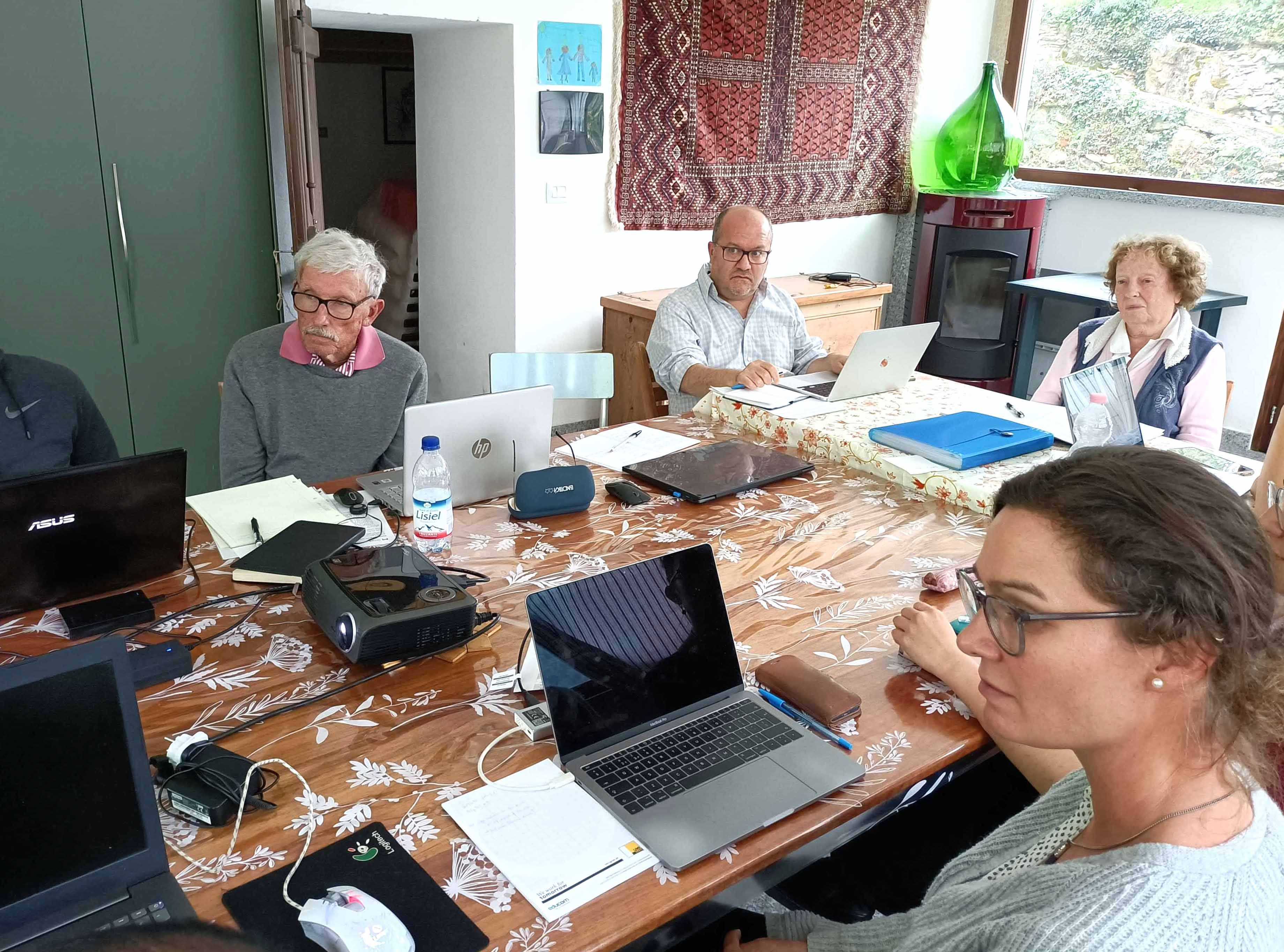 (In the picture, from left to right: James Walker, Samer Abdel-Ghafour, Marilyn Kelly-Buccellati, Laerke Recht).
(In the picture, from left to right: James Walker, Samer Abdel-Ghafour, Marilyn Kelly-Buccellati, Laerke Recht).
Back to top: Extended Report
Morning Session – the UGR “left-hand side”: projections for future work
Tuesday, September 6: the morning session was devoted to a general session dedicated to a specific aspect of the UGR system, namely the “left-hand side”. Prof. Giorgio Buccellati explained to the team the basic theoretical concepts of this frame: this section of the webpage of each digital book is conceived as the place where the author of a digital book can provide a synthesis of the main features of a specific unit or topic.
Back to top: Extended Report
Afternoon Session – UGR “topical books”: “Ceramics” as a model, new topics
The afternoon session of Tuesday, September 6, dealt with the “UGR Topical Books”. After a general introduction by Prof. Giorgio Buccellati, Prof. Marilyn Kelly-Buccellati, Sarah Comelli, Arwa Kharobi, Yasmine Mahmoud, and Laerke Recht described the current status and future developments of the “UGR Topical Books”, which are dedicated to “Grammar”, “Ceramics”, “Conservation”, and “Glyptics”. Three further topical books are going to be created, namely the ones about “Figurines” (by Yasmine Mahmoud), “Biological Anthropology” (by Arwa Kharobi), and “Metals” (by Sarah Comelli). ). The “Ceramics” topical book, which can be regarded as a model for all the other topical books, has been carefully presented by Prof. Marilyn Kelly-Buccellati; the main aim of the future work of the people working on these books will consist in structuring the other topical books following the basic format of the “Ceramics” book, reviewing the data already present in their specific topical book and inputting new data.
Back to top: Extended Report
Wednesday, September 7
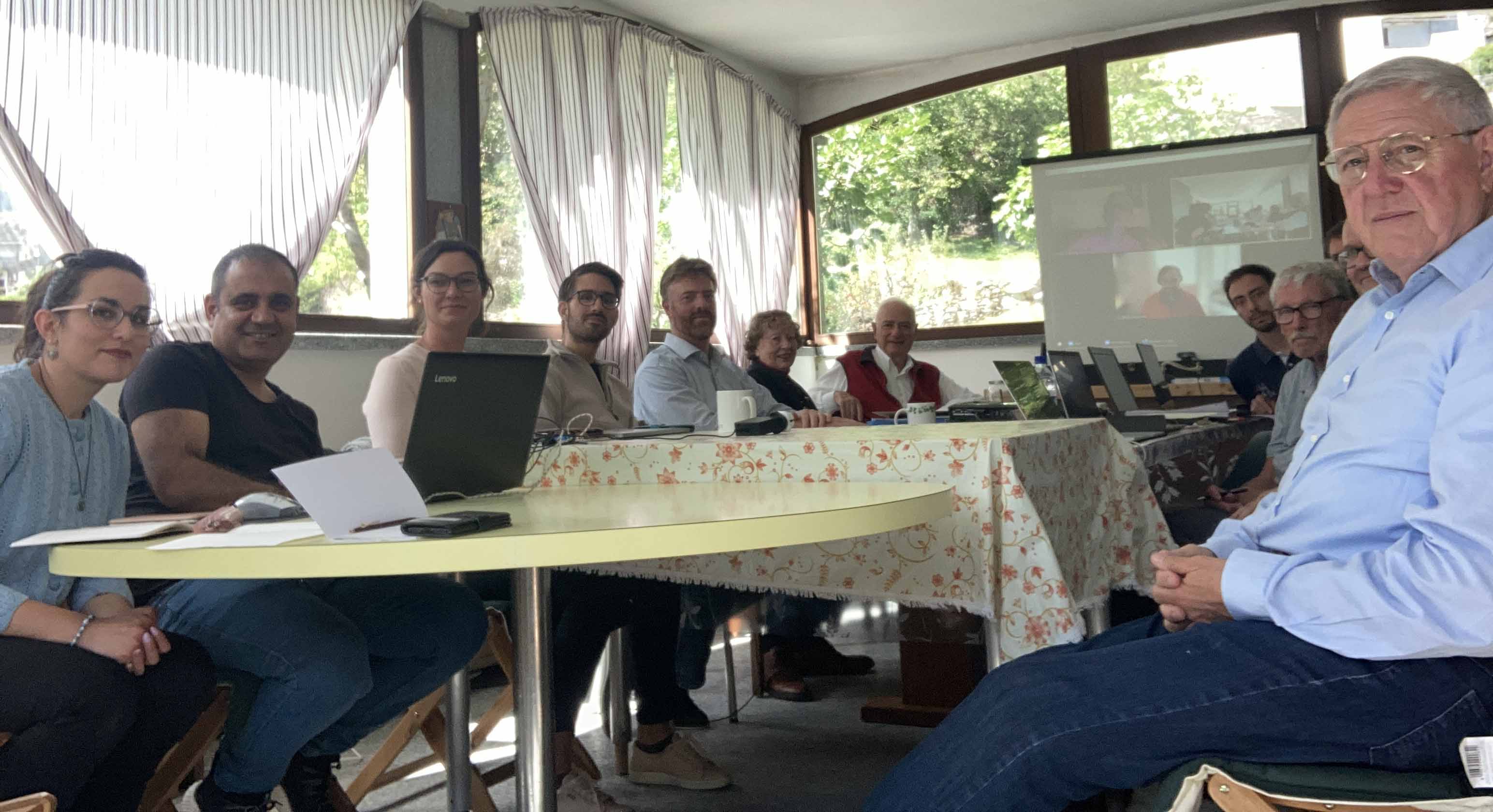 (In the picture, from left to right; left side: Jessica Scaciga, Amer Ahmad, Laerke Recht, Marco De Pietri, Jonah Lynch, Marilyn Kelly-Buccellati, Giorgio Buccellati; right side: Bernardo Forni, Lorenzo Crescioli, James Walker, Samer Abdel-Ghafour, Rodolfo Signorini).
(In the picture, from left to right; left side: Jessica Scaciga, Amer Ahmad, Laerke Recht, Marco De Pietri, Jonah Lynch, Marilyn Kelly-Buccellati, Giorgio Buccellati; right side: Bernardo Forni, Lorenzo Crescioli, James Walker, Samer Abdel-Ghafour, Rodolfo Signorini).
Back to top: Extended Report
Morning Session – urkesh.org: content and format of the overall website
On Wednesday, September 7, the morning general session was dedicated to the analysis of the urkesh.org website as a whole: in this session, the team discussed about both the content and the format of the overall website.
As for the content, the website is regarded not merely as a container of data, but even as a transparent and coherent system made up of different sections, which are accessible on its homepage. These main sections are 13: “Overview”, “Project”, “Website”, “Education”, “Methodology”, “Setting”, “Typology”, “Interpretation”, “Community”, “Preservation”, “Record”, “e-Library”, and “Search”. Each section develops a specific topic, but different sections can be also linked to one another in the spirit of creating a coherent “digital discourse”. Besides, these main sections, the homepage gives also access to other webpages related to the urkesh.org website: these are “Mozan Commons” (a reserved-access section which can be considered as a “social forum” for the staff working on the website), “Critique” (linking to the “4Banks” website about the Critique of Archaeological Reason), “The Park” (about the project of the “Eco-Archaeological Park” of Tell Mozan), and “Urkesh beyond Urkesh” (linking to the website of the association AVASA). Some contents of the website (which is now in a “beta version”) are still in the form of stubs but they are going to be further developed in the next future.
About the format, the website is now basically structured coherently and is written in an HTML format: since this system is actually structured with different “frames” and “sub-frames”, which are sometimes difficult to manage, in the future a new program written on purpose by Bernardo Forni (merging a program called JD with another program called DABI), will allow the team to input data and to structure webpages more easily. The input of data works through different input programs developed in the past, which are still well-working and will be therefore used also in the future, after some required implementations.
Back to top: Extended Report
Afternoon Session – heritage: the digital dimension
The afternoon general session of Wednesday, September 7, was instead about the “Heritage Project”, mostly focusing on the digital dimension of this ongoing cluster including different programs. After a general introduction by Prof. Giorgio Buccellati, the team moved to present the current results and future developments of the “Heritage and Educational Projects”, which includes (within the frame of the wider “Youngsters without Borders” project) the “One-on-One Project” and the “Classroom-to-Classroom Project” (led by Hiba Qassar); the latter developed in the recent past years, involving the participation of schools in Baceno, Corinth, Gaza, Qamishli, and the USA. Alongside this, the “Music Project” (led by Ezio Sartori) saw the involvement of schools in Domodossola and Qamishli. Further long-term initiatives, such as the “Atelier” and the “Eco-Archaeological Park” (led by Prof. Federico Buccellati), are going to be further developed, together with other exhibits and publications (the latter are already easily accessible in electronic format on the “Urkesh/e-Library”), and the site presentation (directed by Amer Ahmad).
Back to top: Extended Report
Thursday, September 8
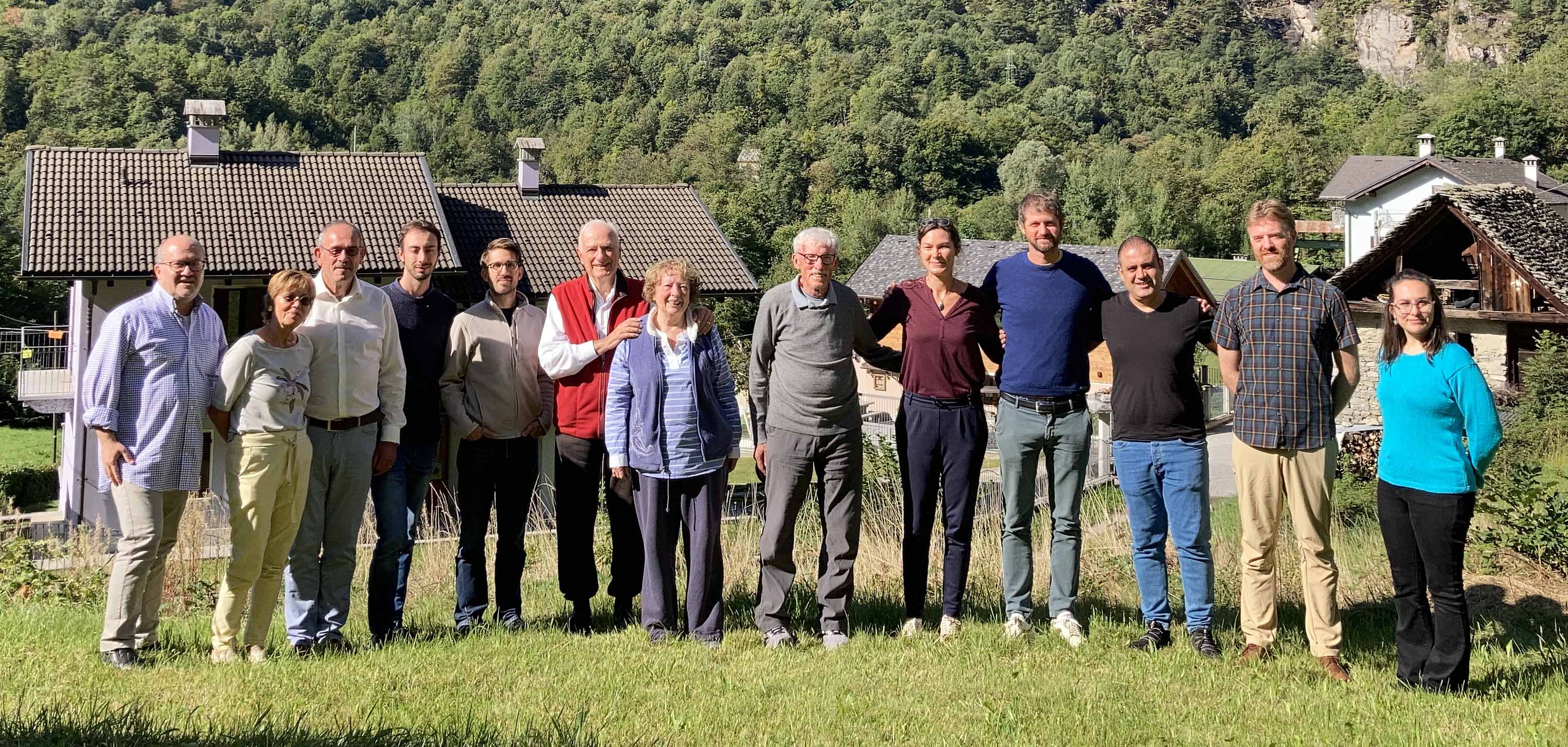 (In the picture, from left to right: Samer Abdel-Ghafour, Mrs. Kuon, Peter Kuon, Bernardo Forni, Marco De Pietri, Giorgio Buccellati, Marilyn Kelly-Buccellati, James Walker, Laerke Recht, Lorenzo Crescioli, Amer Ahmad, Jonah Lynch, Jessica Scaciga).
(In the picture, from left to right: Samer Abdel-Ghafour, Mrs. Kuon, Peter Kuon, Bernardo Forni, Marco De Pietri, Giorgio Buccellati, Marilyn Kelly-Buccellati, James Walker, Laerke Recht, Lorenzo Crescioli, Amer Ahmad, Jonah Lynch, Jessica Scaciga).
Back to top: Extended Report
Morning Session – the bibliographical project and the DABI program
The morning session of Thursday, September 8, was about the bibliographical project “4Banks”: Prof. Giorgio Buccellati, Marco De Pietri, Jonah Lynch, and Laerke Recht presented a report concerning the bibliographical websites working (partially or fully) with the new system DABI (“Digital Analysis of Bibliographical Information”), written by Bernardo Forni, namely the “4Banks” cluster. More in detail, after a general overview by Prof. Giorgio Buccellati about the coherence of the “4Banks” hub as a whole, Laerke Recht has presented the CAR (“Critique of the Archaeological Reason”) website, which is the only one opened to the wider public, thus far. Then, Jonah Lynch has briefly explained the structure of the website about the “Mesopotamian Religion”, which was at first conceived as a companion website to the book “When on High the Heavens…” (by Giorgio Buccellati, Routledge, forth.), but later developed as an independent tool where a proper, coherent digital discourse is displayed, of course in connection to the paper publication. The website, which is expected to be opened soon, has been further enriched by a system of “multimodal indexes”, built up by Jonah Lynch, a system which allows a comparison between different bibliographical entries located in the website itself. Furthermore, Marco De Pietri (associated editor for the website about “Mesopotamian Politics”), illustrated how the work on this website will be on the paths of the collective and teamwork already experienced with the website about the “Mesopotamian Religion”, with weekly meetings between a few scholars, with different expertise in various fields of the ancient Near East, which led in the end to develop a website which is not a mere container of information, but even further insights on specific topics related to the main theme of the book the website is related to. One further step will be about the possibility of connecting all these websites, creating a dialogue between the different digital discourses unfolded in the different websites. The other bibliographical websites, namely the one about “Akkadian Language”, and the other ones dedicated to “Mesopotamian Politics”, “Mesopotamian Art”, and “Mesopotamian Literature” are still a work in progress; for all these websites, an associated editor has been assigned, and editorial boards will be established soon, to guarantee the scientifical quality of their contents. The theory behind all these websites has been clearly developed and explained by Prof. Giorgio Buccellati in the section about the concept of “digital discourse” (“d-discourse”).
Back to top: Extended Report
Afternoon Session – plenary conclusive session
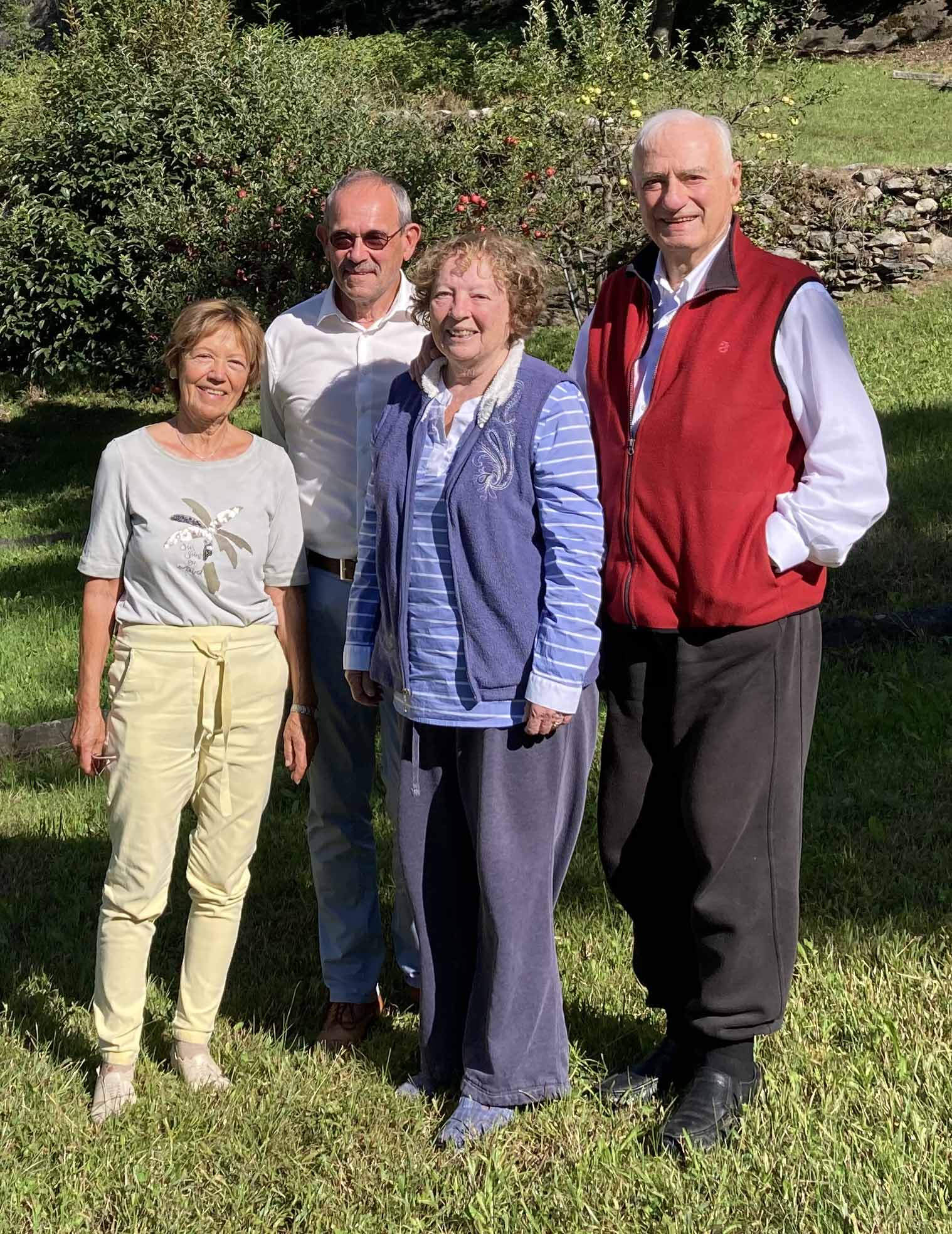 (In the picture, from left to right: Mrs. Kuon, Peter Kuon, Marilyn Kelly-Buccellati, Giorgio Buccellati).
(In the picture, from left to right: Mrs. Kuon, Peter Kuon, Marilyn Kelly-Buccellati, Giorgio Buccellati).
The plenary, afternoon session on Thursday, September 8, was a special moment for the whole team; in fact, the workshop was honored with the presence of Prof. Peter Kuon (University of Salzburg), Vice Chairman of the “Balzan General Prize Committee”, together with his wife, whose kindness and inspiring words have strongly reinforced the commitment of the team towards the project. In this plenary session, after a general introduction by Prof. Giorgio Buccellati, Prof. Marilyn Kelly-Buccellati, and Prof. Federico Buccellati, each member of the team had the opportunity to briefly present and discuss together with the team and the honorable guests his/her current work on some of the many projects conducted under the aegis of the overall “Cybernetica Mesopotamica Balzan Research Project 2022-2025”; at the end of all the presentations, some of them presented online, Prof. Giorgio Buccellati summarized the main trajectories of the project, underlining both the transparency and the coherence of the overall system. After this conclusion, Prof. Peter Kuon and his wife kindly addressed the team, encouraging it to keep working on this framework of interactive and communal effort, stressing the importance of seeing how this workshop perfectly fits the main guidelines and overall spirit of the “Balzan Prize”, aiming at encouraging projects conducted by young researchers.
At first, Prof. Giorgio Buccellati, together with Prof. Marilyn Kelly-Buccellati and Prof. Federico Buccellati, outlined the main goals of the different projects and the underlying methodology, which can be summarized with two keywords: transparency and coherence; all the many “fragments” of the projects (that is, the different websites, or sections of a website) have to be integrated into an overall “system” intended as a coherent whole. As many words, sentences, and passages are the main constituents of a text, or as many sounds, clusters, and words are the basic patterns for a coherent discourse, in the same way, the different websites are regarded as singular constituents of an overall coherent and transparent integrated system. Websites are, in fact, not considered as mere containers of information but even as means to convey a meaningful discourse, which is indeed a digital discourse (“d-discourse”; see also Buccellati, G. 2022, “Transformative Transitions: Learning from a Distant Past”, DirittoPolitecnico.it 1/2022, pp. 127-139).
After this preliminary introduction, Prof. Federico Buccellati, Lorenzo Crescioli, Marco De Pietri, Mary Stancavage, and James Walker explained the ongoing work on the “UGR Unit Books” (that is, the digital books dedicated to the various units excavated at Tell Mozan), pinpointing the major features of this digital publications and the key elements behind this system. Thus far, 11 “Unit Books” have reached a fair degree of internal coherence (even if many of them are still a work in progress) and have been so displayed on the Urkesh website’s homepage, under the section “Record” (namely, these books are A12, A15, A16, A20, J1, J2, J3, J4, J5, J7, and OH2). Further books are still at a very preliminary version and are therefore not yet displayed on the homepage (but are even accessible under the section “Record”, on the left-hand side).
About “UGR Programming and Communication”, Bernardo Forni (the webmaster of the team), reported about the new Python implementation, web presence, and data permanence, while Samer Abdel Ghafour presented an update about “Media Outreach”, that is, the way to further disseminate and share the content of the many websites pertaining to our projects even to a wider public, throughout the help of the social media.
As for the site conservation, many photographs document the efforts of the local population to preserve and consolidate the structures of the site: on the main urkesh.org website, a specific section (the topical book “Conservation”) will display pictures sent by Amer Ahmad and Yasmine Mahmoud which attest for many different operation conducted on the site to preserve the ancient structures (basically, burlap fixing, cleaning, and weed removal); furthermore, the specific section “Conservation” under the book about the Royal Palace AP, will provide for each wall of the building a photographic documentation including a picture per year accompanied by a text describing the state of preservation of that specific wall (or even a side of a wall); this year-by-year reports have been written thus far on the basis on photographic documentation (apart from a professional and autoptic evaluation stated in 2010 by Elizabeth Drolet) by Amer Ahmad and Yasmine Mahmoud, while in the future an autoptic evaluation will be conducted on site. Another effort attesting to the involvement of the local population in the preservation of ancient heritage is the documentation of “surface finds”, that is objects found scattered on many places of the mound of Mozan: a specific page of the “Mozan Sitewide” section (kept updated by Amer Ahmad) will be devoted to collect all the photographic documentation which was performed thus far, and is still in progress.
In the end, Prof. Giorgio Buccellati presented to the team and the two guests the new hub website called “Cybernetica Mesopotamica”, specifically developed after (and also thanks to) the Balzan Prize; this website, after a preface which states the theoretical framework behind all the aforementioned websites, displays the hub of the many connections between the different websites related to different projects, and will offer, besides the proposal presented for the Balzan Prize, a chronicle, collecting all the events (alongside the IIMAS and the AVASA websites, the latter available both in English and Italian) and publications related to the “Cybernetica Mesopotamica Balzan Research Project 2022-2025”, the interim and final reports on the forthcoming achievements, and even the reports and recordings of the workshops periodically taken (in person or virtually) by the team.
Back to top: Extended Report
Friday, September 9 - Monday, September 12: Technical applications of the new UGR program
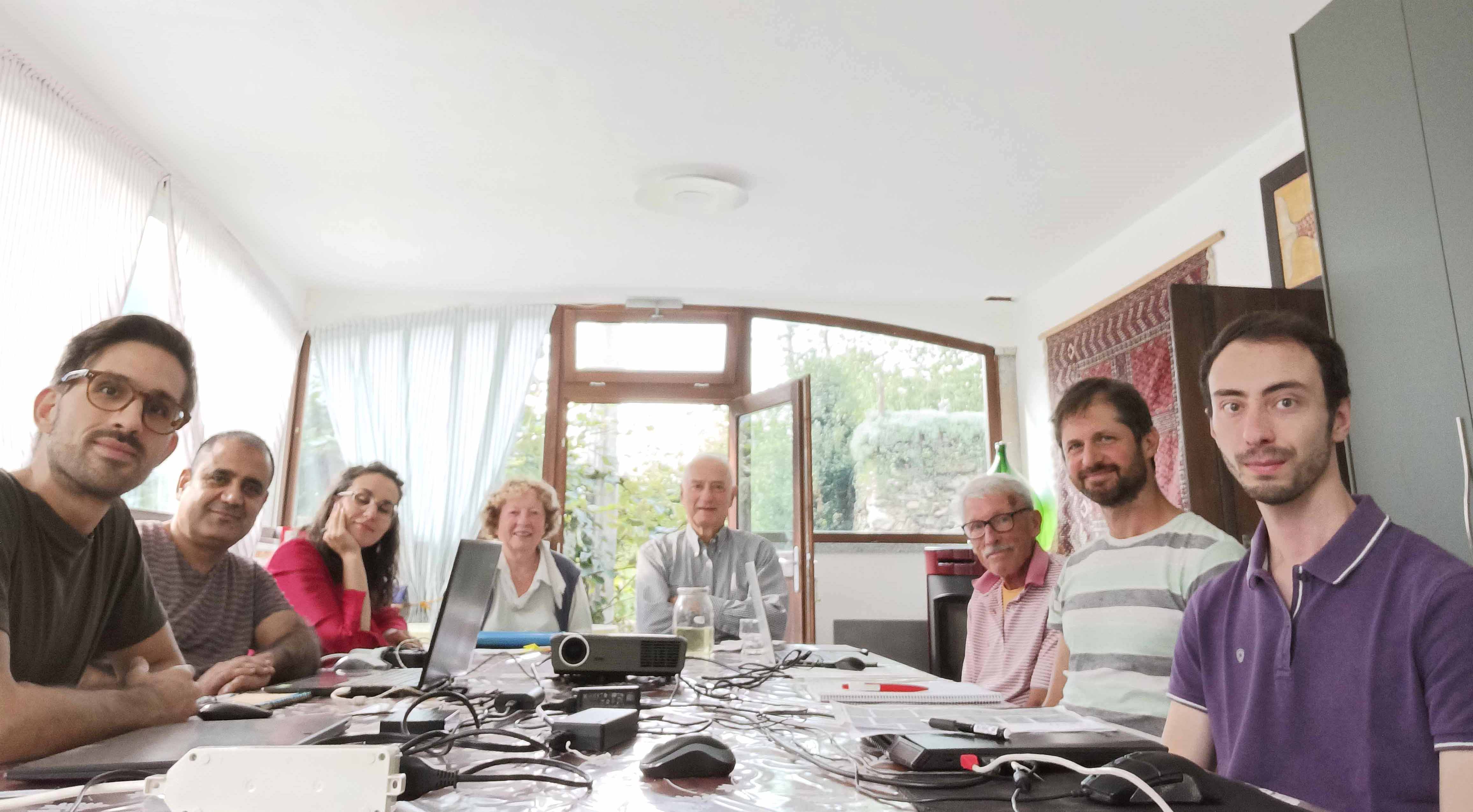 (In the picture, from left to right; left side: Marco De Pietri, Amer Ahmad, Jessica Scaciga; front: Marilyn Kelly-Buccellati, Giorgio Buccellati; right side: James Walker, Lorenzo Crescioli, Bernardo Forni).
(In the picture, from left to right; left side: Marco De Pietri, Amer Ahmad, Jessica Scaciga; front: Marilyn Kelly-Buccellati, Giorgio Buccellati; right side: James Walker, Lorenzo Crescioli, Bernardo Forni).
From Friday, September 9 to Monday, September 12, many sessions of work have been dedicated to technical applications of the new UGR program.
Back to top: Extended Report
Conclusions
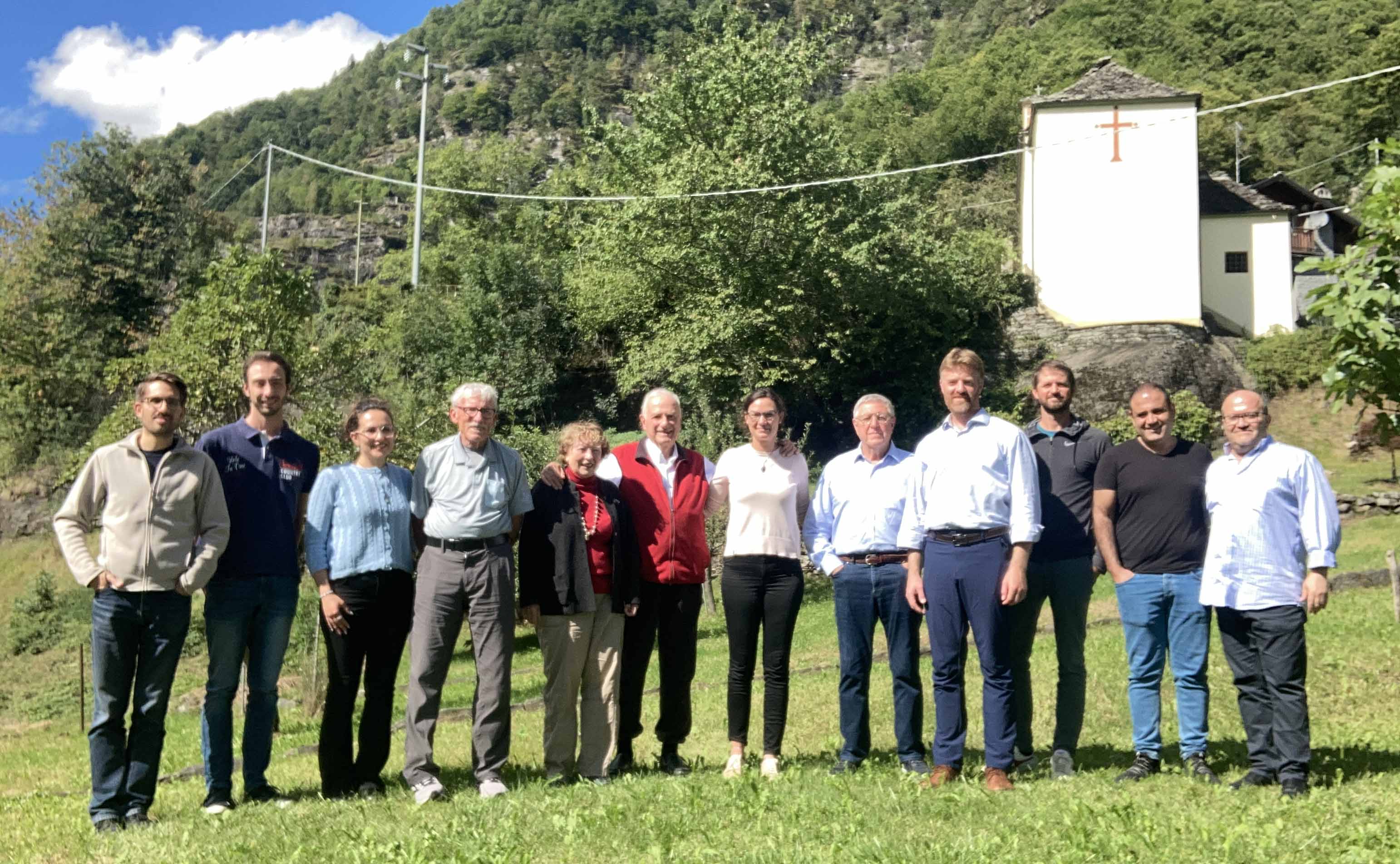 (In the picture, from left to right; Marco De Pietri, Bernardo Forni, Jessica Scaciga, James Walker, Marilyn Kelly-Buccellati, Giorgio Buccellati, Laerke Recht, Rodolfo Signorini, Jonah Lynch, Lorenzo Crescioli, Amer Ahmad, Samer Abdel-Ghafour).
(In the picture, from left to right; Marco De Pietri, Bernardo Forni, Jessica Scaciga, James Walker, Marilyn Kelly-Buccellati, Giorgio Buccellati, Laerke Recht, Rodolfo Signorini, Jonah Lynch, Lorenzo Crescioli, Amer Ahmad, Samer Abdel-Ghafour).
The “Workshop Beola 2” officially ended on Monday, September 12; nevertheless, some members of the team (Samer Abdel Ghafour, Bernardo Forni, Marco De Pietri, Yasmine Mahmoud, Jessica Scaciga, and James Walker) spent (under the supervision of Prof. Giorgio Buccellati and Prof. Marilyn Kelly-Buccellati) some further days together (namely, September 13–14) to further work on some specific aspects of the forthcoming efforts.
In the end, the workshop turned out to be a very successful and fruitful event, mostly for two reasons: 1) the large team of people working on different projects related to Urkesh/Tell Mozan and the “4Banks” websites had the chance to meet in person (but even on remote) after many years (the last plenary workshop took place in 2011); 2) this communal work was indeed a precious moment for sharing ideas and elaborate practical strategies for the next steps of our work, establishing a precise agenda for the future, to achieve many different goals, fostering the knowledge about Urkesh, and preserving a shared awareness towards the heritage of its distant (but even always “present”) past.
PDF version downloadable here.
Back to top: Extended Report